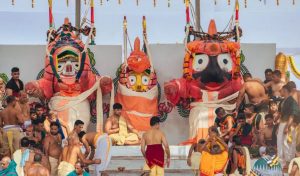A RARE SNANA YATRA

The annual Snana Yatra, the sacred bathing ritual of Lord Jagannath, was once held within the precincts of the Srimandir in Puri. Lord Jagannath, revered as the presiding deity of Odias, embodies human-like activities. Each year, accompanied by His siblings, Lord Balabhadra and Devi Subhadra, He embarks on a journey to the Gundicha Temple on chariots and returns to the temple’s sanctum after a nine-day sojourn. This vibrant festival, globally renowned as the Rath Yatra, has occasionally faced interruptions in its long history.
Historical records reveal that the Rath Yatra was halted for extended periods due to Mughal invasions. According to historian and researcher Surendra Kumar Mishra, the temple faced 18 attacks, resulting in Lord Jagannath’s absence from Puri for approximately 164 years and four months. During this period, the Rath Yatra was conducted only nine times, with eight instances occurring outside Puri—at Gadakujanga for five years, and once each at Gadamanatri, Chilika Lake’s Mahisha-Barahampur islet, and Nairi village on the northern banks of Chilika Lake. For 155 years, the Rath Yatra remained suspended.
A notable exception occurred in 1692, when both the Snana Yatra and Rath Yatra were conducted within the temple’s fortified walls due to an impending attack. That year, Mughal commander Ekram Khan, on the orders of Aurangzeb, invaded the temple. Fearing desecration, the temple priests relocated Lord Jagannath’s idol first to the rear of Devi Bimala’s temple within the complex, and later to the Bhagabati temple at Gadakokal in Brahmagiri via the Bhargavi river. Ekram Khan breached the temple’s Lion’s Gate, and his brother, Maramast Khan, ascended the Ratna Bedi, the temple’s sanctum, only to find a sandalwood idol adorned with precious gemstone eyes. The invaders looted treasures and took the idol to Cuttack. Historian Kedarnath Mahapatra, citing the Madala Panji, Mughal records, and Chakada Pothi (palm leaf manuscripts) accounts, mentions that King Dibyasingh Dev could not resist the attack. To protect the deities, a strategic deception was employed: Ekram Khan was given a replica idol and 30,000 rupees, prompting his departure. He sent these to the Bijapur treasury of the Mughal emperor. The original idols were secretly brought back from Gadakokal, where the Chandan Yatra had already concluded. Upon their return, the temple’s four gates were sealed, and worship was conducted covertly, with only select priests accessing the sanctum through a hidden southern gate. The Mahadeep was also not lit atop the temple on the day of Ekadashi. That year, the Snana Yatra deviated from tradition. Typically held at the Snana Mandap in the temple’s Ananda Bazaar on Jyestha Purnima, the ritual was instead performed on a wooden throne near the Ratna Bedi, where Lord Jagannath’s Nabajaubana Besha (youthful attire) is usually displayed. That year, the ceremony occurred without devotees, a rare occurrence in the temple’s history, underscoring the extraordinary circumstances of the time.
News